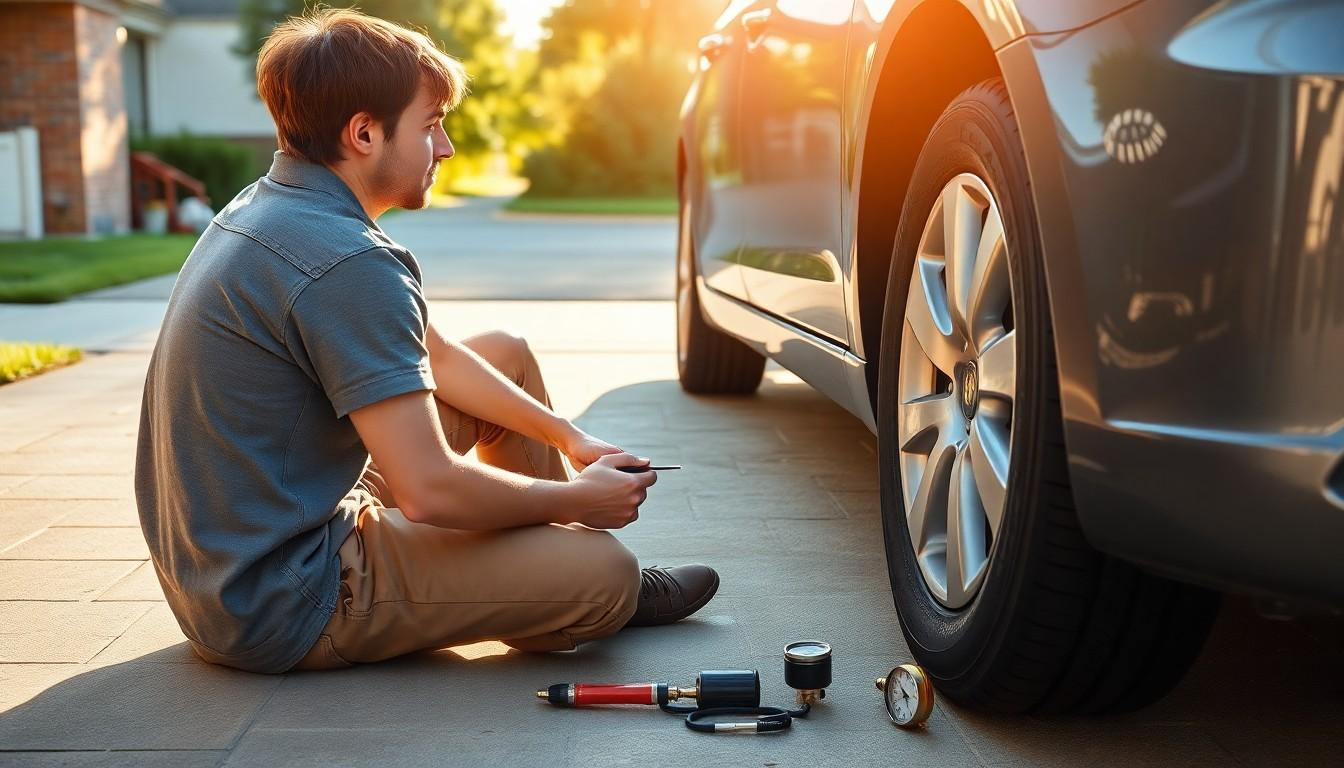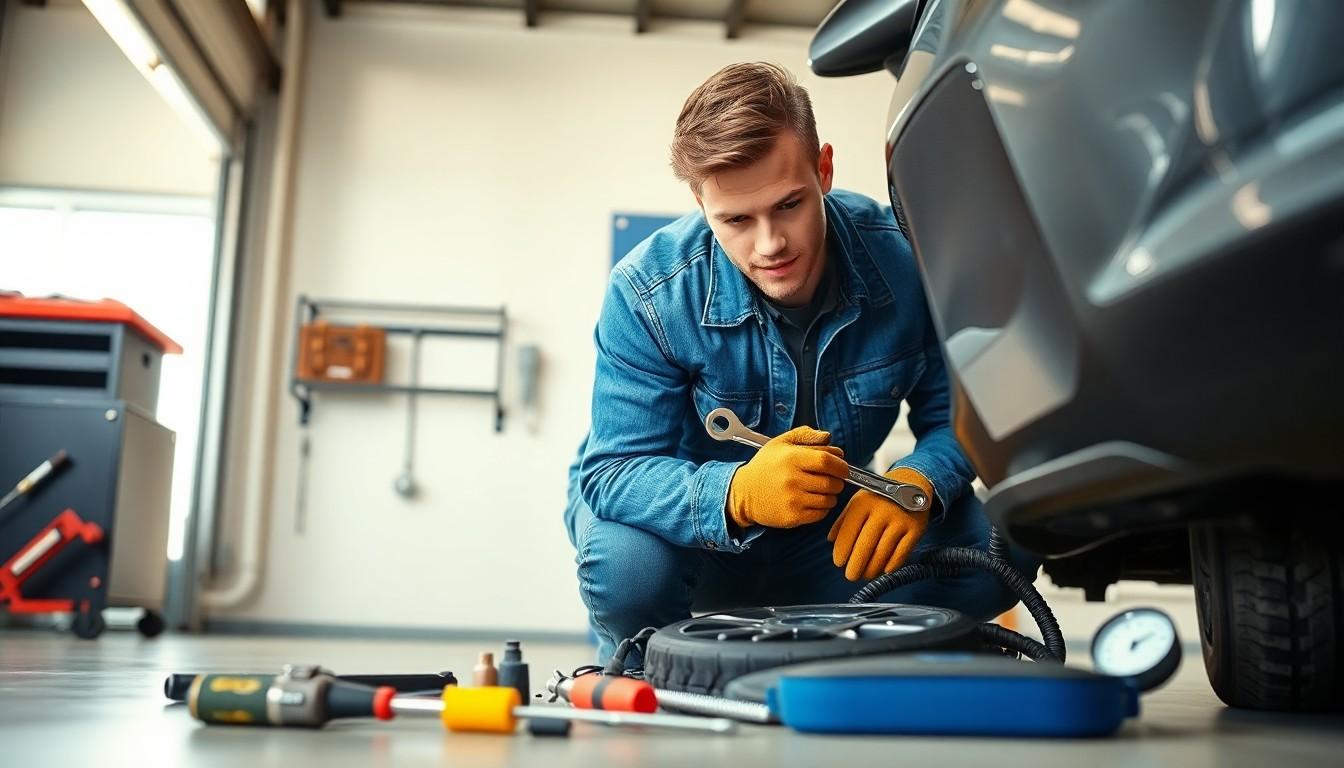Every car owner knows the sinking feeling when that little warning light pops up on the dashboard. Instead of panicking and heading straight to the mechanic, why not roll up those sleeves and tackle some DIY car maintenance? After all, who wouldn’t want to impress friends with their newfound skills and save a few bucks while they’re at it?
DIY Car Maintenance Tips for Beginners
Having the right tools simplifies DIY car maintenance tasks. Investing in essential equipment can enhance efficiency and ensure tasks are completed correctly.
Basic Tool Kit
A basic tool kit includes several vital items. Wrenches in various sizes help loosen or tighten bolts effectively. Screwdrivers, both flathead and Phillips, are crucial for various repairs. Pliers offer the ability to grip and cut components securely. A socket set allows quick access to different sizes for various nuts and bolts. A jack and jack stands provide proper support when working underneath a vehicle. Lastly, a tire pressure gauge ensures tires are inflated to the correct levels.
Maintenance Equipment
Maintenance equipment comprises items that facilitate regular checks and repairs. An oil filter wrench simplifies engine oil changes. A funnel makes pouring fluids more manageable and mess-free. Oil catch pans safely collect old oil for proper disposal. Jump-start cables help revive a dead battery without professional assistance. Tire inflators or compressors restore proper tire pressure quickly. A diagnostic scanner identifies engine issues by reading trouble codes, expediting troubleshooting efforts.
Routine Maintenance Tasks

Routine maintenance tasks ensure a vehicle runs smoothly and efficiently. Performing these tasks regularly saves money and prolongs a car’s lifespan.
Checking Oil Levels
Checking oil levels occurs during routine maintenance. One should locate the dipstick in the engine compartment, pull it out, and clean it with a cloth. Insert it back in, then pull it out again to check the oil level. Oil should be between the minimum and maximum marks. If levels are low, adding oil using the appropriate type is essential. Regular oil checks prevent engine wear and tear, contributing to longer engine life.
Changing Air Filters
Changing air filters regularly enhances engine performance. Start by locating the air filter housing, often on top of the engine. Removing the old filter requires unclipping the housing or unscrewing it. Next, insert the new filter, ensuring it fits snugly. Clean air filters improve airflow and efficiency, leading to better fuel mileage. It’s recommended to change the air filter every 12,000 to 15,000 miles, though specific conditions may necessitate more frequent changes.
Inspecting Tire Pressure
Inspecting tire pressure is a straightforward task that enhances safety and fuel efficiency. Utilize a tire pressure gauge to measure pressure when tires are cold. Both under-inflated and over-inflated tires can cause uneven wear and affect handling. Adjusting tire pressure according to the manufacturer’s specifications, usually found on a sticker inside the driver’s door, is necessary. Checking tire pressure monthly helps maintain optimal performance and ensures a smoother ride.
Common DIY Repairs
Performing common repairs can enhance car maintenance skills while helping save money. The following tasks are easy to handle and can be done with minimal tools.
Replacing Windshield Wipers
Changing windshield wipers involves simple steps that improve visibility during rain. First, lift the wiper arm away from the windshield. Next, locate the release tab on the wiper blade and press it to detach the old blade. Choose a new wiper blade that matches the length specified in the vehicle’s manual. Align the new blade with the wiper arm and click it into place. Finally, lower the arm gently back onto the windshield. Regular wiper replacement every six months ensures improved safety and blocks streaking.
Changing Headlight Bulbs
Swapping out headlight bulbs is another straightforward DIY task that boosts safety at night. Start by opening the hood and locating the back of the headlight assembly. Depending on the vehicle model, either twist the socket counterclockwise to release it or undo any clips. Remove the old bulb and insert the new one, taking care not to touch the glass with bare hands. Secure the socket back into the assembly by twisting it clockwise or fastening the clips. Properly functioning headlights enhance visibility and ensure compliance with safety regulations.
Safety Tips for DIY Maintenance
Safety remains a top priority for DIY car maintenance. Taking proper precautions protects personal well-being and prevents accidents.
Using Jack Stands
Using jack stands is crucial when working underneath a vehicle. Ensure the jack stands are rated for the weight of the car, with most models supporting 2 to 3 tons. Position the stands on a flat surface to avoid slipping. Place them under secure points of the vehicle frame for stability. Always lower the car onto the stands after lifting it with a jack; avoiding reliance solely on the jack keeps the vehicle secure.
Wearing Protective Gear
Wearing protective gear safeguards against potential injuries during maintenance. Gloves provide grip and shield hands from cuts or abrasions. Safety goggles protect eyes from debris and fluids, especially when dealing with oil changes or brake work. Steel-toed boots offer protection against heavy objects that might fall. Lastly, using a dust mask helps reduce inhalation of harmful particles, especially when changing air filters or working in dusty environments.
Embracing DIY car maintenance can transform the way car owners approach vehicle care. By taking on simple tasks like checking oil levels or replacing windshield wipers, they not only save money but also gain valuable skills that enhance their confidence.
Equipping themselves with the right tools and safety gear ensures they can tackle repairs effectively and safely. Regular maintenance not only prolongs a car’s lifespan but also contributes to optimal performance on the road.
With a bit of knowledge and practice, anyone can master the essentials of car maintenance, making it an enjoyable and rewarding experience.

